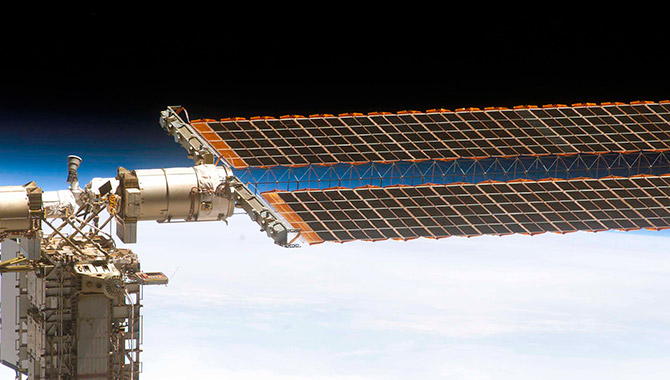
Langley Research Center systems engineer Kevin “Vip” Vipavetz shared a compilation of lessons from developing solar array structures and mechanisms—a high-risk component for many missions after launch and on orbit.
Solar array structures are big and complex. They harness sunlight to provide power to spacecraft of all sizes—from CubeSats to the International Space Station (ISS). The solar arrays on the ISS contain 262,400 solar cells, have a wingspan of 240 feet (almost 30 feet longer than a Boeing 777’s wingspan), and an electrical power system connected by eight miles of wire. Developing solar array structures and mechanisms can be expensive and complicated.
In order for a larger NASA audience to benefit from the agency’s lessons learned about solar array structures, NASA’s Human Exploration Operations Mission Directorate (HEOMD) hosted a September virtual knowledge forum featuring Langley Research Center senior systems engineer Kevin Vipavetz.
“One of the biggest problems we have when developing solar array structures is that we can’t really fully test them on the ground. They’re just so big,” explained Vipavetz. “Trying to get a full system into a test facility would be ideal, but is usually impractical. These things are as big as football fields or bigger. You usually don’t have a facility to put them in.”
In addition to discussing the challenges of testing solar array structures, Vipavetz covered four general categories of commonly reported anomalies and failures with solar arrays: mechanical loading, on-orbit space environments, tribology (e.g., mechanisms and lubricants), and systems engineering. A variety of scenarios can lead to problems: ground transportation damaging graphite/epoxy structures; orbital debris; environmental disturbances such as geomagnetic storms; and breakdowns in good systems engineering involving poor requirements definition, quality of workmanship, and lack of communication.
Vipavetz emphasized the importance of making the time to develop a good set of system requirements. While it’s common for engineers to want to get started designing and building, he said, “What you find out is that you know your section or your area, but you don’t know the interactions and the interfaces on either side of that, and how what you do will affect the system. One of the key things you’ve got to do up front is really spend the time developing [solutions to] end-to-end problems and work with end-to-end systems requirements. That’s the hardest thing I’ve always faced.”
Download the full presentation. (PDF)
A 115-foot Solar Array Wing extends from the International Space Station as it orbits 220 miles above Earth. This photo shows a portion of the wing’s 32,800 solar cells that produce 32 kilowatts of electricity – enough to power 16 homes.
Download: Fullsize
Photo Credit: NASA








